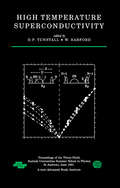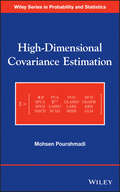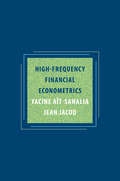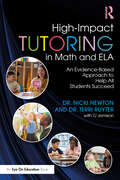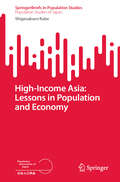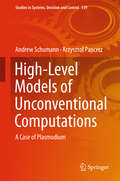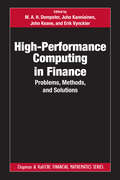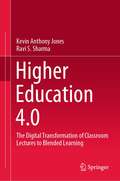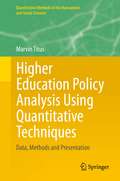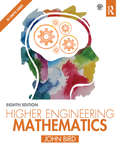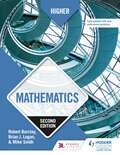- Table View
- List View
High School Math Solution, Integrated Math III, Volume 2
by Sandy Bartle Finocchi Amy Jones Lewis Josh Fisher Janet Sinopoli Victoria FisherNIMAC-sourced textbook
High Temperature Superconductivity (Scottish Graduate Ser. #39)
by D P TunstallHigh Temperature Superconductivity provides a broad survey of high temperature superconductivity, discussing the adaptations of experimental and theoretical techniques and methods that take advantage of the revolutionary properties of high temperature superconductors. Distinguished engineers, chemists, and experimental and theoretical physicists introduce their own particular area of the field before going on to explain current theories and techniques. The book is divided into three sections: materials, mechanisms, and devices. Topics covered include synthetic approaches to the growth of new materials; optical, magnetic, and electrical characterization of synthesized materials; strong correlations; the magnon pairing mechanism; and technical background of device performance in new materials. A coherent introduction to high temperature superconductivity, this volume will be invaluable to researchers in condensed matter physics, chemistry, materials science, and engineering.
High-Dimensional Covariance Estimation
by Mohsen PourahmadiMethods for estimating sparse and large covariance matricesCovariance and correlation matrices play fundamental roles in every aspect of the analysis of multivariate data collected from a variety of fields including business and economics, health care, engineering, and environmental and physical sciences. High-Dimensional Covariance Estimation provides accessible and comprehensive coverage of the classical and modern approaches for estimating covariance matrices as well as their applications to the rapidly developing areas lying at the intersection of statistics and machine learning.Recently, the classical sample covariance methodologies have been modified and improved upon to meet the needs of statisticians and researchers dealing with large correlated datasets. High-Dimensional Covariance Estimation focuses on the methodologies based on shrinkage, thresholding, and penalized likelihood with applications to Gaussian graphical models, prediction, and mean-variance portfolio management. The book relies heavily on regression-based ideas and interpretations to connect and unify many existing methods and algorithms for the task.High-Dimensional Covariance Estimation features chapters on:Data, Sparsity, and RegularizationRegularizing the EigenstructureBanding, Tapering, and ThresholdingCovariance MatricesSparse Gaussian Graphical ModelsMultivariate RegressionThe book is an ideal resource for researchers in statistics, mathematics, business and economics, computer sciences, and engineering, as well as a useful text or supplement for graduate-level courses in multivariate analysis, covariance estimation, statistical learning, and high-dimensional data analysis.
High-Dimensional Covariance Matrix Estimation: An Introduction to Random Matrix Theory (SpringerBriefs in Applied Statistics and Econometrics)
by Aygul ZagidullinaThis book presents covariance matrix estimation and related aspects of random matrix theory. It focuses on the sample covariance matrix estimator and provides a holistic description of its properties under two asymptotic regimes: the traditional one, and the high-dimensional regime that better fits the big data context. It draws attention to the deficiencies of standard statistical tools when used in the high-dimensional setting, and introduces the basic concepts and major results related to spectral statistics and random matrix theory under high-dimensional asymptotics in an understandable and reader-friendly way. The aim of this book is to inspire applied statisticians, econometricians, and machine learning practitioners who analyze high-dimensional data to apply the recent developments in their work.
High-Dimensional Optimization: Set Exploration in the Non-Asymptotic Regime (SpringerBriefs in Optimization)
by Anatoly Zhigljavsky Jack NoonanThis book is interdisciplinary and unites several areas of applied probability, statistics, and computational mathematics including computer experiments, optimal experimental design, and global optimization. The bulk of the book is based on several recent papers by the authors but also contains new results. Considering applications, this brief highlights multistart and other methods of global optimizations requiring efficient exploration of the domain of optimization. This book is accessible to a wide range of readers; the prerequisites for reading the book are rather low, and many numerical examples are provided that pictorially illustrate the main ideas, methods, and conclusions. The main purpose of this book is the construction of efficient exploration strategies of high-dimensional sets. In high dimensions, the asymptotic arguments could be practically misleading and hence the emphasis on the non-asymptotic regime. An important link with global optimization stems from the observation that approximate covering is one of the key concepts associated with multistart and other key random search algorithms. In addition to global optimization, important applications of the results are computer experiments and machine learning. It is demonstrated that the asymptotically optimal space-filling designs, such as pure random sampling or low-discrepancy point nets, could be rather inefficient in the non-asymptotic regime and the authors suggest ways of increasing the efficiency of such designs. The range of techniques ranges from experimental design, Monte Carlo, and asymptotic expansions in the central limit theorem to multivariate geometry, theory of lattices, and numerical integration. This book could be useful to a wide circle of readers, especially those specializing in global optimization, numerical analysis, computer experiments, and computational mathematics. As specific recipes for improving set exploration schemes are formulated, the book can also be used by the practitioners interested in applications only.
High-Dimensional Probability: An Introduction with Applications in Data Science (Cambridge Series in Statistical and Probabilistic Mathematics #47)
by Roman VershyninHigh-dimensional probability offers insight into the behavior of random vectors, random matrices, random subspaces, and objects used to quantify uncertainty in high dimensions. Drawing on ideas from probability, analysis, and geometry, it lends itself to applications in mathematics, statistics, theoretical computer science, signal processing, optimization, and more. It is the first to integrate theory, key tools, and modern applications of high-dimensional probability. Concentration inequalities form the core, and it covers both classical results such as Hoeffding's and Chernoff's inequalities and modern developments such as the matrix Bernstein's inequality. It then introduces the powerful methods based on stochastic processes, including such tools as Slepian's, Sudakov's, and Dudley's inequalities, as well as generic chaining and bounds based on VC dimension. A broad range of illustrations is embedded throughout, including classical and modern results for covariance estimation, clustering, networks, semidefinite programming, coding, dimension reduction, matrix completion, machine learning, compressed sensing, and sparse regression.
High-Dimensional Statistics: A Non-Asymptotic Viewpoint (Cambridge Series in Statistical and Probabilistic Mathematics #48)
by Martin J. WainwrightRecent years have witnessed an explosion in the volume and variety of data collected in all scientific disciplines and industrial settings. Such massive data sets present a number of challenges to researchers in statistics and machine learning. This book provides a self-contained introduction to the area of high-dimensional statistics, aimed at the first-year graduate level. It includes chapters that are focused on core methodology and theory - including tail bounds, concentration inequalities, uniform laws and empirical process, and random matrices - as well as chapters devoted to in-depth exploration of particular model classes - including sparse linear models, matrix models with rank constraints, graphical models, and various types of non-parametric models. With hundreds of worked examples and exercises, this text is intended both for courses and for self-study by graduate students and researchers in statistics, machine learning, and related fields who must understand, apply, and adapt modern statistical methods suited to large-scale data.
High-Frequency Financial Econometrics
by Yacine Aït-Sahalia Jean JacodA comprehensive introduction to the statistical and econometric methods for analyzing high-frequency financial dataHigh-frequency trading is an algorithm-based computerized trading practice that allows firms to trade stocks in milliseconds. Over the last fifteen years, the use of statistical and econometric methods for analyzing high-frequency financial data has grown exponentially. This growth has been driven by the increasing availability of such data, the technological advancements that make high-frequency trading strategies possible, and the need of practitioners to analyze these data. This comprehensive book introduces readers to these emerging methods and tools of analysis.Yacine Aït-Sahalia and Jean Jacod cover the mathematical foundations of stochastic processes, describe the primary characteristics of high-frequency financial data, and present the asymptotic concepts that their analysis relies on. Aït-Sahalia and Jacod also deal with estimation of the volatility portion of the model, including methods that are robust to market microstructure noise, and address estimation and testing questions involving the jump part of the model. As they demonstrate, the practical importance and relevance of jumps in financial data are universally recognized, but only recently have econometric methods become available to rigorously analyze jump processes.Aït-Sahalia and Jacod approach high-frequency econometrics with a distinct focus on the financial side of matters while maintaining technical rigor, which makes this book invaluable to researchers and practitioners alike.
High-Impact Tutoring in Math and ELA: An Evidence-Based Approach to Help All Students Succeed
by Nicki NewtonHigh-impact tutoring programs are ramping up across the country to address learning recovery post-COVID. But how do you make the most of them? This invaluable book has the answers!You’ll find out the best ways to implement high-dosage tutoring, including what it is and what it is not, how to overcome common challenges, how to establish a program and create a collaborative team, the role of the tutor, relationship building, onboarding and professional development, high-quality curriculum and study skills, assessing students’ needs, incorporating MTSS, and more. In addition, the appendix offers a variety of diagnostic and progress-monitoring tools you can use in your own setting.With this indispensable resource, you’ll have the tools you need to help close the achievement gap so your students can thrive in math and ELA.
High-Income Asia: Lessons in Population and Economy (SpringerBriefs in Population Studies)
by Shigesaburo KabeThis book focuses on the high-income Asia that experienced fast economic growth and rapid demographic change in recent decades. High-income Asia includes Japan, South Korea, Taiwan, Singapore and Hong Kong, according to the World Bank&’s category classification. These economies enjoyed a brief period of brilliant economic growth but then faced a demographic shift, with the lowest fertility in the world. For example, Japan today must confront difficult challenges such as how to balance childbirth and childcare with women&’s employment as its population rapidly ages—a consequence that was hardly foreseen in the process of economic growth. The changing landscape is different at each stage of the process, and the issues related to economic growth cannot be clearly recognized before or during that growth. Therefore, as a reference for the future of developing countries, this book aims to provide positive and negative lessons, learned from high-income Asia&’s experiences in high-speed economic growth and demographic changes. First, it gives an overview of the rapid economic growth and demographic changes in high-income Asia over the past several decades. Then, among the challenges following economic growth, it focuses on two points: 1) how to balance childbirth and childcare with women&’s employment; and 2) how to respond to the anticipated labor shortage in the future. The former issue requires a delicate balance between preventing fertility decline and supporting women's employment. Here, a comparison among Japan, Taiwan and Korea is made. The latter question focuses primarily on Japan as the fastest-aging population in the world, with additional reference to parts of high-income Asia other than Japan, which also are aging. Based on analyses of these major points, the author discusses the policy implications for developing countries learned from the tough lessons of high-income Asia.
High-Level Models of Unconventional Computations: A Case Of Plasmodium (Studies in Systems, Decision and Control #159)
by Krzysztof Pancerz Andrew SchumannThis book shows that the plasmodium of Physarum polycephalum can be considered a natural labelled transition system, and based on this, it proposes high-level programming models for controlling the plasmodium behaviour. The presented programming is a form of pure behaviourism: the authors consider the possibility of simulating all basic stimulus–reaction relations. As plasmodium is a good experimental medium for behaviouristic models, the book applies the programming tools for modelling plasmodia as unconventional computers in different behavioural sciences based on studying the stimulus–reaction relations. The authors examine these relations within the framework of a bio-inspired game theory on plasmodia they have developed i.e. within an experimental game theory, where, on the one hand, all basic definitions are verified in experiments with Physarum polycephalum and Badhamia utricularis and, on the other hand, all basic algorithms are implemented in the object-oriented language for simulations of plasmodia. The results allow the authors to propose that the plasmodium can be a model for concurrent games and context-based games.
High-Performance Computational Solutions in Protein Bioinformatics
by Dariusz MrozekRecent developments in computer science enable algorithms previously perceived as too time-consuming to now be efficiently used for applications in bioinformatics and life sciences. This work focuses on proteins and their structures, protein structure similarity searching at main representation levels and various techniques that can be used to accelerate similarity searches. Divided into four parts, the first part provides a formal model of 3D protein structures for functional genomics, comparative bioinformatics and molecular modeling. The second part focuses on the use of multithreading for efficient approximate searching on protein secondary structures. The third and fourth parts concentrate on finding 3D protein structure similarities with the support of GPUs and cloud computing. Parts three and four both describe the acceleration of different methods. The text will be of interest to researchers and software developers working in the field of structural bioinformatics and biomedical databases.
High-Performance Computing Using FPGAs
by Khaled Benkrid Wim VanderbauwhedeHigh-Performance Computing using FPGA covers the area of high performance reconfigurable computing (HPRC). This book provides an overview of architectures, tools and applications for High-Performance Reconfigurable Computing (HPRC). FPGAs offer very high I/O bandwidth and fine-grained, custom and flexible parallelism and with the ever-increasing computational needs coupled with the frequency/power wall, the increasing maturity and capabilities of FPGAs, and the advent of multicore processors which has caused the acceptance of parallel computational models. The Part on architectures will introduce different FPGA-based HPC platforms: attached co-processor HPRC architectures such as the CHREC's Novo-G and EPCC's Maxwell systems; tightly coupled HRPC architectures, e.g. the Convey hybrid-core computer; reconfigurably networked HPRC architectures, e.g. the QPACE system, and standalone HPRC architectures such as EPFL's CONFETTI system. The Part on Tools will focus on high-level programming approaches for HPRC, with chapters on C-to-Gate tools (such as Impulse-C, AutoESL, Handel-C, MORA-C++); Graphical tools (MATLAB-Simulink, NI LabVIEW); Domain-specific languages, languages for heterogeneous computing(for example OpenCL, Microsoft's Kiwi and Alchemy projects). The part on Applications will present case from several application domains where HPRC has been used successfully, such as Bioinformatics and Computational Biology; Financial Computing; Stencil computations; Information retrieval; Lattice QCD; Astrophysics simulations; Weather and climate modeling.
High-Performance Computing in Finance: Problems, Methods, and Solutions (Chapman and Hall/CRC Financial Mathematics Series)
by M. A. H. Dempster, Juho Kanniainen, John Keane and Erik VynckierHigh-Performance Computing (HPC) delivers higher computational performance to solve problems in science, engineering and finance. There are various HPC resources available for different needs, ranging from cloud computing– that can be used without much expertise and expense – to more tailored hardware, such as Field-Programmable Gate Arrays (FPGAs) or D-Wave’s quantum computer systems. High-Performance Computing in Finance is the first book that provides a state-of-the-art introduction to HPC for finance, capturing both academically and practically relevant problems.
High-Precision Methods in Eigenvalue Problems and Their Applications
by Leonid D. Akulenko Sergei V. NesterovThis book presents a survey of analytical, asymptotic, numerical, and combined methods of solving eigenvalue problems. It considers the new method of accelerated convergence for solving problems of the Sturm-Liouville type as well as boundary-value problems with boundary conditions of the first, second, and third kind. The authors also present high
High-Temperature Superconducting Microwave Circuits and Applications
by Haiwen Liu Baoping Ren Xuehui Guan Pin Wen Tao ZuoHigh-temperature superconducting (HTS) materials are becoming more and more attractive in the context of designing RF/microwave filters because of their lower losses and excellent performance. This book focuses on the superconducting microwave filter and its application in modern communication. It first presents the basic principles, HTS materials and processing and then introduces several types of multi-band HTS bandpass filter (BPF), discussing their properties and analyzing equivalent circuit models and their performances. This book is a valuable resource for students and researchers who are interested in wireless communication and RF/microwave design.
High-dimensional Microarray Data Analysis: Cancer Gene Diagnosis and Malignancy Indexes by Microarray
by Shuichi ShinmuraThis book shows how to decompose high-dimensional microarrays into small subspaces (Small Matryoshkas, SMs), statistically analyze them, and perform cancer gene diagnosis. The information is useful for genetic experts, anyone who analyzes genetic data, and students to use as practical textbooks.Discriminant analysis is the best approach for microarray consisting of normal and cancer classes. Microarrays are linearly separable data (LSD, Fact 3). However, because most linear discriminant function (LDF) cannot discriminate LSD theoretically and error rates are high, no one had discovered Fact 3 until now. Hard-margin SVM (H-SVM) and Revised IP-OLDF (RIP) can find Fact3 easily. LSD has the Matryoshka structure and is easily decomposed into many SMs (Fact 4). Because all SMs are small samples and LSD, statistical methods analyze SMs easily. However, useful results cannot be obtained. On the other hand, H-SVM and RIP can discriminate two classes in SM entirely. RatioSV is the ratio of SV distance and discriminant range. The maximum RatioSVs of six microarrays is over 11.67%. This fact shows that SV separates two classes by window width (11.67%). Such easy discrimination has been unresolved since 1970. The reason is revealed by facts presented here, so this book can be read and enjoyed like a mystery novel. Many studies point out that it is difficult to separate signal and noise in a high-dimensional gene space. However, the definition of the signal is not clear. Convincing evidence is presented that LSD is a signal. Statistical analysis of the genes contained in the SM cannot provide useful information, but it shows that the discriminant score (DS) discriminated by RIP or H-SVM is easily LSD. For example, the Alon microarray has 2,000 genes which can be divided into 66 SMs. If 66 DSs are used as variables, the result is a 66-dimensional data. These signal data can be analyzed to find malignancy indicators by principal component analysis and cluster analysis.
High-quality and Timely Statistics: New Methods and Applications (Studies in Theoretical and Applied Statistics)
by Maurizio Vichi Marco Mingione Giorgia ZaccariaThis book addresses a wide range of recent methodological aspects, applications and best practices of statistics production. It comprises a selection of peer-reviewed contributions of methodological and applied interest presented at the 4th Conference of European Statistics Stakeholders, CESS 2022, held in Rome, Italy, on October 20-21, 2022. The first part discusses statistical methods with applications to environmental risk assessment, sentinels data, surveillance systems during the Covid-19 pandemic, healthcare risk management, the analysis of regional or structural changes of scale, household distributional accounts, regional rental prices on municipalities, the network topology of the Euro area interbank market, tourism statistics and big data, statistical literacy, and Sustainable Development Goal composite indicators for EU countries. The second part focuses on statistical methodologies for complex data analysis, namely the optimal number of clusters to rank a model-based index, clustering methods for asymmetric data using spectral approaches, a family of parsimonious matrix-variate mixture models for heavy-tailed data, the importance of robust second-stage regressions for financial data, and on perturbation methods. In view of the overarching theme “The European Data Ecosystem for the Statistical Information of the Digital Age” and the importance of statistical data for monitoring the progress of the United Nations’ Sustainable Development Goals, the CESS 2022 meeting provided a forum for discussion on methodologies, results, challenges and best practices among methodologists, producers, and users of European Statistics from academia, the national statistical offices and the institutions of the European Union. Chapter Estimating regional rental prices on LAU 2 municipalities in North Rhine-Westphalia is available open access under a Creative Commons Attribution 4.0 International License via link.springer.com.
Higher Education 4.0: The Digital Transformation of Classroom Lectures to Blended Learning
by Kevin Anthony Jones Sharma RavishankarThis book chronicles a 10-year introduction of blended learning into the delivery at a leading technological university, with a longstanding tradition of technology-enabled teaching and learning, and state-of-the-art infrastructure. Hence, both teachers and students were familiar with the idea of online courses. Despite this, the longitudinal experiment did not proceed as expected. Though few technical problems, it required behavioural changes from teachers and learners, thus unearthing a host of socio-technical issues, challenges, and conundrums. With the undercurrent of design ideals such as “tech for good”, any industrial sector must examine whether digital platforms are credible substitutes or at best complementary. In this era of Industry 4.0, higher education, like any other industry, should not be about the creative destruction of what we value in universities, but their digital transformation. The book concludes with an agenda for large, repeatable Randomised Controlled Trials (RCTs) to validate digital platforms that could fulfil the aspirations of the key stakeholder groups – students, faculty, and regulators as well as delving into the role of Massive Open Online Courses (MOOCs) as surrogates for “fees-free” higher education and whether the design of such a HiEd 4.0 platform is even a credible proposition. Specifically, the book examines the data-driven evidence within a design-based research methodology to present outcomes of two alternative instructional designs evaluated – traditional lecturing and blended learning. Based on the research findings and statistical analysis, it concludes that the inexorable shift to online delivery of education must be guided by informed educational management and innovation.
Higher Education Policy Analysis Using Quantitative Techniques: Data, Methods and Presentation (Quantitative Methods in the Humanities and Social Sciences)
by Marvin TitusThis textbook introduces graduate students in education and policy research to data and statistical methods in state-level higher education policy analysis. It also serves as a methodological guide to students, practitioners, and researchers who want a clear approach to conducting higher education policy analysis that involves the use of institutional- and state-level secondary data and quantitative methods ranging from descriptive to advanced statistical techniques. This book is unique in that it introduces readers to various types of data sources and quantitative methods utilized in policy research and in that it demonstrates how results of statistical analyses should be presented to higher education policy makers. It helps to bridge the gap between researchers, policy makers, and practitioners both within education policy and between other fields.Coverage includes identifying pertinent data sources, the creation and management of customized data sets, teaching beginning and advanced statistical methods and analyses, and the presentation of analyses for different audiences (including higher education policy makers).
Higher Engineering Mathematics
by John BirdNow in its eighth edition, Higher Engineering Mathematics has helped thousands of students succeed in their exams. Theory is kept to a minimum, with the emphasis firmly placed on problem-solving skills, making this a thoroughly practical introduction to the advanced engineering mathematics that students need to master. The extensive and thorough topic coverage makes this an ideal text for upper-level vocational courses and for undergraduate degree courses. It is also supported by a fully updated companion website with resources for both students and lecturers. It has full solutions to all 2,000 further questions contained in the 277 practice exercises.
Higher Geometry: An Introduction to Advanced Methods in Analytic Geometry
by Frederick S. WoodsFor students of mathematics with a sound background in analytic geometry and some knowledge of determinants, this volume has long been among the best available expositions of advanced work on projective and algebraic geometry. Developed from Professor Woods' lectures at the Massachusetts Institute of Technology, it bridges the gap between intermediate studies in the field and highly specialized works.With exceptional thoroughness, it presents the most important general concepts and methods of advanced algebraic geometry (as distinguished from differential geometry). It offers a thorough study of one-, two-, three-, and four-dimensional coordinated systems, the concepts they entail, and their associated geometrical elements. This study culminates with a discussion of n-dimensional geometry in an abstract sense, of which the earlier subjects form concrete illustrations.As each system of coordinates is introduced, the meaning of the linear and quadratic equations is studied, with principal emphasis on the interpretation of equations as well as on a knowledge of useful geometrical facts. The principle of duality is kept at the forefront, and the nature of imaginary elements and the conventional character of the locus of infinity, dependent upon the type of coordinates used, are carefully explained.
Higher Index Theory (Cambridge Studies in Advanced Mathematics #189)
by Guoliang Yu Rufus WillettIndex theory studies the solutions to differential equations on geometric spaces, their relation to the underlying geometry and topology, and applications to physics. If the space of solutions is infinite dimensional, it becomes necessary to generalise the classical Fredholm index using tools from the K-theory of operator algebras. This leads to higher index theory, a rapidly developing subject with connections to noncommutative geometry, large-scale geometry, manifold topology and geometry, and operator algebras. Aimed at geometers, topologists and operator algebraists, this book takes a friendly and concrete approach to this exciting theory, focusing on the main conjectures in the area and their applications outside of it. A well-balanced combination of detailed introductory material (with exercises), cutting-edge developments and references to the wider literature make this a valuable guide to this active area for graduate students and experts alike.
Higher Mathematics for Science and Engineering
by Aliakbar Montazer Haghighi Dimitar P. Mishev Abburi Anil KumarThis textbook provides a comprehensive, thorough and up-to-date treatment of topics of mathematics that an engineer and scientist would need, at the basic levels that contents of engineering and sciences are built by. For this purpose, natural readers would be junior and senior undergraduate students, who normally have the content of this book under different names on their degree plans. Also, engineers and scientists will benefit from this book since the book is a comprehensive volume for such audiences.This book is written in a way that it balances both theory and practical applications of topics from linear algebra, matrix theory, calculus of multivariable, theory of complex variables, several transforms, ordinary and partial differential equations, difference equations, optimization, probability, statistics, theory of reliability and finally, applications from variety of areas of sciences and engineering.
Higher Mathematics, Second Edition
by Robert Barclay Mike Smith Brian LoganThe complete textbook for the SQA Higher Maths course, updated in accordance with latest syllabus guidelines.- Arranged by topic, but with complete flexibility to teach in preferred order - Unique 'hinge-point' questions to test readiness to progress further in each topic - or go back and revise - Written by three outstanding and experienced teachers, examiners and authors

